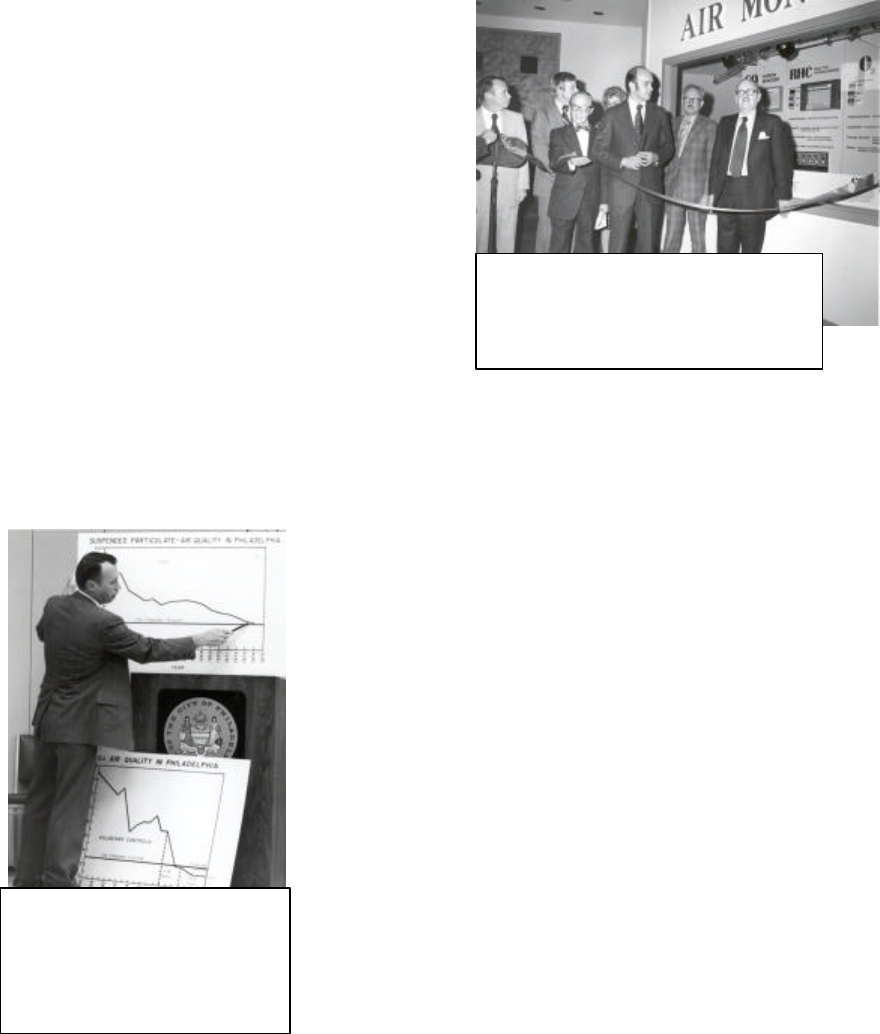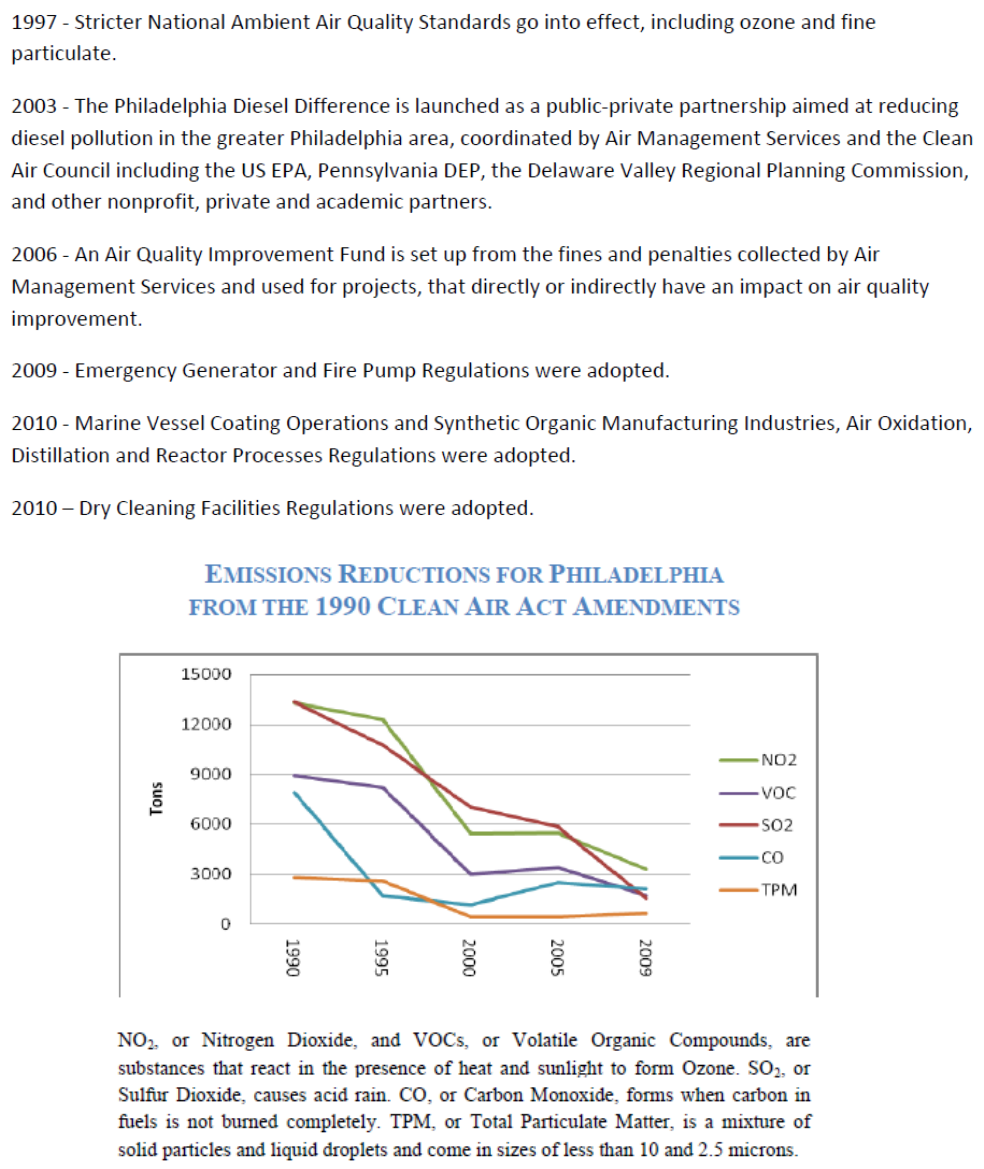
HISTORY of Air Pollution Control in Philadelphia
1904 Philadelphia passed an ordinance to regulate emission of smoke from
chimneys, stacks, flues or open spaces, providing a color scale for the measurement
of the degree of darkness of such smoke, making it unlawful to permit the escape of
smoke of a certain degree of darkness and providing a penalty for the violation of the
ordinance. It was enforced by the Bureau of Boiler Inspectors.
1948 A City Council ordinance established The Division Of Air Pollution Control and
The Air Pollution Control Board in the Bureau Of Health in the Department Of Public
Health, defining their power and duties, providing for administration and
enforcement and fixing penalties. The Agency was created in 1949.
1954 A City Council ordinance prohibited open burning and limited smoke emissions.
1954 Environmental Health Services was created. Air Pollution Control became a
Section of Environmental Health Services.
1955 Congress passed the Air Pollution Control Act.
From 1956 to 1963 sulfur dioxide levels in the City of Philadelphia fell almost in half,
and particulate levels declined by 25%.
1958 Inspectors began routine inspections for area surveillance, permit and license
checks, hazardous gas and vapor emissions and in response to reports and concerns
from the public.
1964 Air Management Services’ new laboratory was dedicated, providing a new
modern facility for operation of its air monitoring and sampling activities.
1968 The Pennsylvania Air Pollution Control Commission became dissatisfied with
some of Philadelphia’s air pollution control program activities and decertified
1969 Philadelphia, with much publicity and involvement of City Council and the
public, passed the Air Management Code. The City established Air Management
Services as a division of the Department of Public Health with its head, an Assistant
Health Commissioner, reporting directly to the Health Commissioner. The code now
defined that air pollution emissions in excess of standards promulgated by the Air
Pollution Control Board constituted a nuisance per se. It authorized the Board to
Miss Clean Air 1965
17
th
Annual National Clean Air Week
Walter E. Jackson, Chief
Air Pollution Control Section
Philadelphia Department of Public Health
History of Air Pollution Control in Philadelphia Page 1 of 4

establish air quality objectives and to achieve these goals through the enforcement
of regulations. Philadelphia’s air pollution control program was back in business.
From 1969 to 1971 931 incinerators closed down or were sealed during
implementation of the new regulations. Peco (Philadelphia Electric Company)
reduced sulfur emissions by 61% and particulate emissions by 86%.
1967 The U.S. Clean Air Act Amendment converted criteria pollutant levels into
requirements.
1970 Air Management Services
established a city-wide network of air
monitoring stations, and began a
comprehensive program to reduce
particulates, sulfur dioxide, and
hydrocarbon emissions. Detailed
engineering surveys were made of
companies throughout the city,
compliance schedules were negotiated,
air pollution inspectors patrolled the
city looking for violations and
responding to complaints and
recalcitrant polluters were taken to
court.
1970 Congress passed the Clean Air Act Amendments.
1971 The first annual Earth Day was celebrated.
1971 Philadelphia’s Asbestos Control Regulations were written.
1975 Philadelphia took responsibility for the
implementation of the US EPA National
Emission Standard for Hazardous Air Pollutants
(NESHAP) for asbestos.
1976 Noise and Vibration control were added to
the Air Pollution Control Program.
1978 The sulfur content of heating oil was
limited to .2% in Philadelphia.
1980 The Philadelphia Board of Health adopted
Noise Regulations.
1981 Philadelphia banned coal burning for
heating and cooking.
1981 Philadelphia adopted Air Quality
Guidelines for 99 toxic air pollutants.
1987 the Asbestos Control Program was added
to Air Management Services.
1989 Asbestos Control Regulations were
adopted by the Board of Health.
1975 Dedication of Franklin
Institute Air Monitoring
Station. The exhibit remains,
and was updated in 2000.
1975 Assistant Health
Commissioner William
Reilly showing
Philadelphia’s improving
air quality
History of Air Pollution Control in Philadelphia Page 2 of 4

1990 Clean Air Act Amendments of 1990 were passed, providing a major overhaul of
the Federal air quality regulations, including creation of the Title V section requiring
unified permitting of air pollution from major facilities.
1991 The Commonwealth of PA implemented requirements to certify individuals in
asbestos occupations and state notification prior to the start of asbestos projects.
1996 Autobody refinishing regulations were adopted.
ESTIMATED EMISSIONS AND PERCENTAGE REDUCTION FROM ALL SOUCES
(excludes natural sources) *
Pollutant 1966 1996 Percent
Reduction
Sulfur Dioxide 262,000 tons 16,000 tons 94%
Particulate 80,000 tons 5,900 tons 93%
Nitrogen Oxides 96,000 tons 42,000 tons 56%
Carbon Monoxide 550,000 tons 215,000 tons 61%
Volatile Organic
Compounds
127,000 tons 55,600 tons 56%
City Hall, Then & Now
Using today’s standards, in
1962 (left), over half of all days
would have been considered to
have unhealthful air quality. In
2000 (right) there was only one
unhealthful air quality day.
History of Air Pollution Control in Philadelphia Page 3 of 4

HistoryofAirPollutionControlinPhiladelphiaPage4of4
AirPollutionControlLeaders:
RaySmith,WaltJackson,ArthurWallach,EdWilson(1969‐1972),WilliamReilly(1972‐1991),Robert
Ostrowski(1991‐1998),MorrisFine(1998‐2007),ThomasHuynh(2007‐Present).
